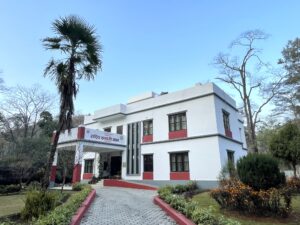The foundation stone for the National Botanical Garden (NBG) was laid by Khagendra Jung Gurung, Deputy Minister of the Ministry of Forests and Agriculture on July 12, 1961 (Asadh 28, 2018). It was formally established on October 28, 1962 (Kartik 12, 2019) and inaugurated by King Mahendra. The NBG, formerly known as the Royal Botanical Garden (RBG), belongs to the Department of Plant Resources (DPR), Ministry of Forests and Environment (MoFE), Government of Nepal (GoN). The landscape of this exquisite botanical garden was designed by two British architects, Geoffrey Herklots and Tony Schilling. It is well-known as a center of plant conservation, education, research, display and recreation. It covers an area of 82 hectares with varying topographies, 40 hectares of which have been transformed into various thematic gardens (= subgardens). It is surrounded by a natural evergreen forest with Schima-Castanospsis-Alnus as the dominant tree species. It is located at the base of Mt. Phulchowki (2765 m), the highest peak of the Kathmandu valley, and lies about 10 km southeast of Satdobato, Lalitpur District. A natural stream, Godawari, runs through the middle of the garden, adding to its beauty.
This is the oldest botanical garden of the nation. It is also an internationally recognized botanical garden and a member of Botanic Gardens Conservation International (BGCI) since 2015 AD. It has a natural plant landscape having 30 different thematic gardens like arboretum, biodiversity education garden, fern garden, Japanese style garden, lily garden, Nepalensis-historic plant garden, physic garden, rock garden, rose garden, school education garden, sand garden, special garden, taxonomic family garden, terrace garden, threatened plant garden, tropical garden, wetland garden, etc. This botanical garden has conserved 1285 species (1300 taxa) of plants, including native, indigenous, naturalized, and exotic angiosperms, gymnosperms, pteridophytes and bryophytes. It has also conserved about 200 species of medicinal and aromatic plants (MAPs), 89 species of orchids, 79 species of climbers, and 60 species of cactus and succulent plants.
More than 586 thousand visitors, including 93 thousand students, visited this botanical garden in the last fiscal year (2079/80). Generally, students come here on educational tours, plant researchers come here to observe living plants, general visitors come here to relax and unwind away from the humdrum of city life, naturalists come here to watch birds and enjoy the scenery/greenery, and film crews come here to shoot videos and films.
The garden opens daily from 9:00 a.m. to 4:00 p.m. from Kartik 16 to Magh 15 (first week of November to last week of January) and from 9:00 a.m. to 5:00 p.m. for the rest of the year. Visitors can enter this garden by paying entrance fee at the main gate of the garden.
Garden Sections: (1) Medicinal Plants and Information Section, (2) Conservation and Education Section, (3) Garden Development Section, and (4) Floriculture Section.
Our Mission: “Exploration and conservation of plant resources for a better life”



